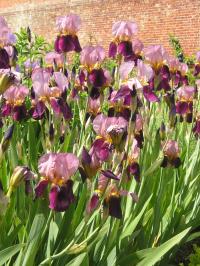Dividing Irises to Improve Flowering
 Dividing Irises can significantly improve flowering
Dividing Irises can significantly improve floweringDividing Rhizomatous Irises in Autumn can significantly improve flowering performance for the following season.
After a busy few weeks in the garden, this week I finally got around to dividing some of the rhizomatous type Irises in the PlantAdvice garden. (Iris rhizomes are the swollen stems at soil level that store water and nutrients). The aim of digging up and dividing these Irises is to improve next year's flowering performance. Unlike many Agapanthus, old, congested clumps of Iris tend to produce far fewer flowers or give up flowering all together.
It is best to carry out this division process of Rhizomatous Iris clumps every 3 or 4 years. It can be done any time after flowering, but try and get the newly planted rhizomes well established before the first frosts
Digging Up
The first thing you do is to dig up the whole clump. You then sort through the plants, looking for the firmest, healthiest rhizomes to replant. Discard any shrivelled, weak rhizomes, cut these off with a clean, sharp knife if they are attached to healthy tissue that you want to re-plant. If there are any obviously young, vigorous new rhizomes these jump to the front of the queue for re-planting.
When you have finished choosing the rhizomes to replant and which to discard, you can start to deal with the roots. Just trim the roots to a uniform length, about 2 inches should be fine.
Cutting Back
The next step is to cut back the leaves; this is done to reduce evaporation from the leaves when they are re-planted and to reduce the effect of wind rock. The newly planted Iris rhizomes need to stabilise and re-root quickly in the soil. To do this, they need to have a lower centre of gravity and do not want to be rocking around in the wind, which they would be more susceptible to if the long leaves were not trimmed. Cut back about ĺ of the leaf.
Reduced leaf evaporation is also important. Think about it; the roots have been trimmed, therefore the plantís ability to absorb moisture has been reduced. It makes sense to cut the leaves down and reduce leaf evaporation doesnít it?
Re-Planting
The rhizomes are now fully prepared for replanting and your hard work so far should be reward with a wonderful display of flowers next year. After digging in some well rotted garden compost or manure, re-planting can now commence.
Plant the prepared rhizomes so that the upper surface of the rhizome is just above the soil level, an exposed rhizome baked in the summer sun will also aid future flowering.
Planting distance depends on the size and vigour of the species or cultivar you are working with. Use a bit of common sense, if you are re-planting dainty, dwarf rhizomatous Irises they can be planted a bit closer together than larger specimens. Go for 6 inches between dwarfs and 10 inches between larger varieties.
Just water the new plantings whilst they are getting established if the weather is dry. I would also recommend feeding the Irises a month or so before you expect them to flower with a fertiliser high in potash e.g. tomato food.
Job done, you can now sit back and wait for that wonderful display of flowers. There is nothing more rewarding in gardening than seeing happier, healthier plants, flowering to their hearts content as a result of your intervention.
Filed under DIY Gardening Jobs.
